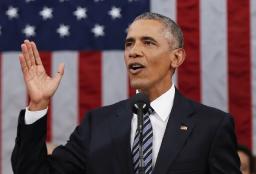How psychologists used these doctored Obama photos to get white people to support conservative politics


"That left a lot of analysts slack-jawed, wondering: What was this latent force that drove the emergence of this movement?" said Robb Willer, a sociologist at Stanford University.
Then, of course, there was Donald Trump.
Willer speculates that one thing connecting these two political earthquakes might be white voters' unconscious racial biases. In a series of psychological experiments between 2011 and 2015 , he showed how hostility toward people with darker skin and perceived racial threats can influence white support for the tea party. He and his colleagues published a draft of a paper on their findings online last week — some of the most direct evidence of the importance of race to the conservative resurgence during Obama's presidency.
First, the researchers randomly sorted subjects into two groups and showed them a series of pictures of celebrities, including digitally altered images of the commander in chief. One group saw a version in which Obama's skin had been lightened, while in the other version, his skin had been darkened.

Among the 101 participants of other races or ethnicities, by contrast, those who saw the lightened image of Obama were twice as likely to support the tea party as those who saw the darkened image. Because they had fewer subjects of color, Willer and his colleagues couldn't rule out the possibility that this difference between the randomly assorted groups was due to chance.
The result suggests that some white Americans are more likely to oppose Obama solely because of the shade of his skin. For them, the reality that someone with a dark complexion occupies the nation's highest office could be a source of unease.

For example, psychologist David Sears and political scientist Michael Tesler found that many white voters were willing to support white liberal politicians such as President Clinton and Secretary of State John Kerry when they were candidates for president, but voted against Obama. Since Clinton, Kerry and Obama all espoused a similar ideology, the pair surmised that Obama must have been less popular because he is black.
Conservative politicians also seemed to respond to racial animosity toward the president. A study last year found that — intentionally or not — some negative advertisements aired against Obama in 2008 showed him with darker skin.
Willer, though, was able to demonstrate the connection between Obama's skin color and conservative opposition experimentally. The researchers also conducted a few more studies to see whether tea party support might be motivated by signs that the position of white Americans as a privileged majority is declining.
The researchers presented two groups of subjects with apparently innocuous reports about U.S. demographic trends and the white share of the population. One group read a report that showed population data only from 2000 to 2020, making it appear that the white majority remains relatively stable. The other group read a report that showed the trend since 1960 and predictions through 2060, forecasting that the white population would decline into a minority.
Again, there were significantly greater levels of white support for the tea party among those who read the second report, which focused on the declining white population. Those who read that report rated their level of support for the tea party at an average of 1.62 points on a five-point scale, where a score of 5 signified "a great deal" of support.
Those who read the first report, showing that the white majority was relatively stable, rated their support at an average of 1.28 points. Again, supporters of the tea party were in the minority in both groups.
Willer and his collaborators repeated the experiment, this time with fictional economic data. In one report, the incomes of ethnic minorities were in decline, while white incomes were unchanged. In the second report, white incomes were declining while other groups' incomes did not change.
In fact, incomes for all racial and ethnic groups have declined in tandem in recent years, with no one group gaining or losing relative to the others.
Yet Willer had a hunch that because white incomes have declined, some of the white participants in the experiment might feel that white households are losing their relative advantage in the U.S. economy. If so, the second report he showed them would have seemed to corroborate this mistaken perception.
Previous research has shown that white Americans tend to see the trend toward racial equity as a kind of competition , in which one group's loss must be another group's gain. In particular, research shows, economic distress can exacerbate racial biases, since they give members of the dominant group the mistaken impression their relative position is endangered. White Americans get "the sense that they have a shrinking piece of a pie that is itself shrinking," Willer explained.
With the second report, Willer and his colleagues showed that their subjects reinforced this unconscious bias and produced greater levels of white support for the tea party: Those who saw that report rated their support for the tea party at an average of 1.45 points. Those who saw the first report, showing incomes for racial minorities declining, rated their support at an average of 1.23 points.
This kind of zero-sum thinking doesn't seem common among racial minorities. If it were, then one would expect that minorities who read the first report -- showing their disadvantage increasing -- would be more likely to oppose the tea party as a protest against white privileges.
On the contrary, participants of color who saw the report that emphasized declining white economic status were more likely to oppose the tea party. Again, this difference might have been the product of random chance.
Willer started this series of experiments in 2011. He was already wrapping up the research when Trump announced his presidential campaign by calling Mexican immigrants criminals, so he doesn't have direct evidence on whether racial biases have contributed to Trump's success. Yet other research , including polling by The Washington Post, suggests that some white voters' perception that their dominance as a racial group is threatened has motivated some to cast ballots for the presumptive Republican nominee.
"A lot of analysts have been shocked to see a major party candidate receive so much popular support despite a track record of controversial statements toward multiple ethnic groups," Willer said. "It's less surprising if you think of the tea party as a sort of historical bridge to the Trump candidacy."
The movement, he explained, might have made using the kind of inflammatory rhetoric that Trump has employed more socially acceptable, and past research suggests that the movement could have created a new sense of racial identity among its supporters.








It seems that these experiments show that White participants were more likely to support the Tea Party when shown a picture of the President with his skin darkened, while people of color had the exact opposite reaction and tended to be more opposed to the Tea Party.
The same reaction was noted when White people were shown fake graphs showing that White income was decreasing, while the income of other groups were the same. These White participants were also more likely to support the Tea Party when shown these phony economic graphs and the same reaction happened when they were shown phony graphs of the White population decreasing (as it really is) and Whites becoming a minority by 2060, which is probably true. Whites who saw those graphs were more likely to support The Tea Party also.
This reaction is bad for America and can lead to a split between the races that will leave each feeling isolated and that they must stay with there own race. This trend looks like this is especially going to happen with White people. Racial purity may rise in the future as the White race does shrink to a minority as it certainly is going to. One would hope this will happen peacefully with brother and sisterhood for all, but there are bound to be the racist groups we already have in America, such as the Klan, growing and becoming more of a force in the future. All good Americans should work towards not allowing this to happen. ANY kind of racial purity is bad for America's future. ANY kind of racial violence or war is bad for America's future. The races and the racial make up of America is going to change no matter what anyone does and we must find ways for it to happen peacefully and reject the racial purists.
I forgot the Red Box Rules Again! Damn it! Well the only rules here are to stay in the CoC and be nice.
Randy, IMO racial purity has been in existence in the US since it's inception and isn't going away anytime soon. It's only going to get worse.
The ones that said they would vote for Clinton or Kerry must have some other underlying condition. It sounds like they could be delusional and suffer from conditions that cause a lack of self respect.